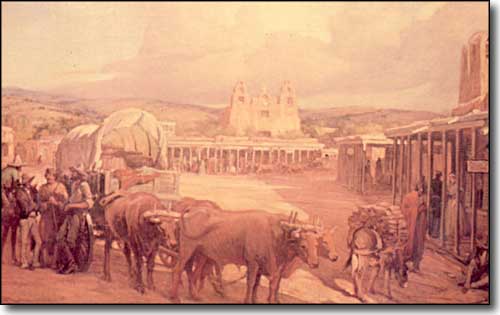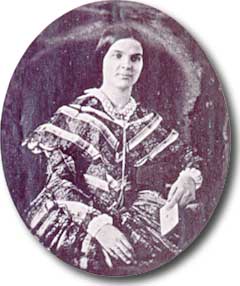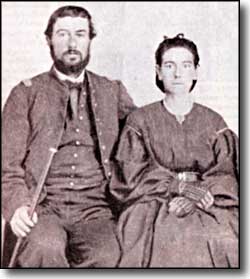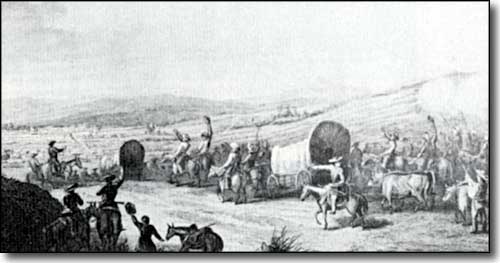 |
Pioneer Women on the Santa Fe Trail |
 The Santa Fe Plaza in early Trail days |

Until 1850, very few women made the journey on the Santa Fe Trail. Indian attack, disease, storms and lightning, buffalo stampedes, prairie fires, rattlesnakes, swollen rivers with quicksandy bottoms, hunger, and thirst made the journey too perilous for most women. The Oregon, California and Mormon Trails were full of whole families heading westward but not the Santa Fe Trail. The summer of 1829 finds the first record of a woman travelling the Trail. Actually, it was 6 women and 10 men who'd been exiled by the government of Mexico in retaliation against Spain. They joined with an American trade caravan and made the journey to Missouri where they disappeared into history, nameless (except for one man: in 1846, he returned to Santa Fe with the Army of the West as the newly appointed American Consul). In 1832, Mary Donoho accompanied her husband William to Santa Fe where they ran a hotel on the Plaza before heading back over the Trail to Missouri five years later. Susan Magoffin, age 19, arrived in Santa Fe in August, 1846. Her diary was found in a descendant's attic in 1926 and published. Susan was a new bride who'd been raised in luxury when she set out from Independence, Missouri with the wagon train of her husband, Samuel, a Santa Fe Trail veteran. He did his best for her: she travelled in a Rockaway carriage with a servant girl to wait on her. She had many delicacies and other foods available. She slept in a spacious tent with a carpet, folding camp furniture and a bed with mattress and linen. (That's Susan Magoffin on the left, above.) The wagon train followed behind Col. Stephen W. Kearny's Army of the West as they made their way to Bent's Fort. Today in the restored fort is "Susan Magoffin's room" with appropriate furnishings for the time. Another woman at Bent's Fort was Charlotte Green, who with her husband Dick and his brother Andrew were house slaves of the Bent brothers. Charlotte was famous up and down the Rockies for her cooking and for her fandango dancing. In 1846 Kearny led his army into Santa Fe and claimed it for the United States. Before heading off to conquer California, he appointed Charles Bent Governor of New Mexico Territory. Bent and Dick Green rode down from Bent's Fort to Bent's home in Taos to assume his civic duties. In January, 1847, Bent left Green in Santa Fe and returned to Taos just in time to be killed in the Taos Uprising. Green returned to Taos with the troops and led the charge on the main rebel stronghold where he was seriously wounded. When William Bent heard of Dick's heroism, he freed the entire Green family. In May of 1847 the Greens headed east from Bent's Fort to St. Louis over the Santa Fe Trail. 
In 1851, Marion Sloan made her first journey on the Santa Fe Trail, travelling with her mother, Eliza, and older brother Will, to Santa Fe where Eliza ran a boardinghouse on a corner of the Santa Fe Plaza (where the Fine Arts Museum stands now). One spring afternoon as she was walking home from school, Marion met Col. Kit Carson. He became a boarder at her mother's place whenever he was in town on business. His pet name for her was "Maid Marion" and they would often walk hand-in-hand around the Plaza. In her teens, Marion visited Fort Union, northeast of Las Vegas, and met and fell in love with Lt. Richard Russell. One day he rode to Santa Fe and, finding her at the Post Office, he proposed. They were wed in the military chapel at Fort Union with Kit Carson as a witness. After he was mustered out of the Army, they settled on a ranch in the Stonewall Valley, west of Trinidad, Colorado. (That's the Russell's on the right) Another early female traveller of the Trail was Julia Archibald Holmes. In 1857, at the age of 20, she married James H. Holmes and moved to his homestead near Emporia, Kansas. Julia's upbringing had been a liberal one and she had been a friend of Susan B. Anthony. On the prairies, she kept in touch with the women's suffrage movement through letters and a subscription to The Lily, founded by Amelia Bloomer and the first national magazine devoted to women's rights. This is where Julia first learned of "bloomers." The following year, 1858, she and her husband joined a wagon train headed for the new gold discoveries at Pikes Peak. At one point along the trail a band of Cheyennes appeared and wanted to barter for her. "My husband received several flattering offers for me," observes Julia. "One Indian wanted to trade two squaws, who could probably perform four times the physical labor that I could." Not long after arriving in the vicinity of the future Colorado Springs, Julia, her husband and several others spent two days climbing Pikes Peak. In later years, women's rights crusaders in Colorado often referred to this as "Mrs. Holmes's Ascension!" In 1859, the Holmeses went to Santa Fe where James had been appointed Secretary of the Territory. They lived there until 1862 with Julia working as a correspondent for the New York Herald Tribune. About 1863 they left the southwest and headed east over the Santa Fe Trail. Julia died in 1887 after working for years as a clerk in the Bureau of Education in Washington, DC. She's still remembered as the bloomer girl who first climbed Pike's Peak. |
 Caravan arriving from Missouri, from Josiah Gregg's Commerce of the Prairies |

|
| Index - Arizona - Colorado - Idaho - Montana - Nevada - New Mexico - Utah - Wyoming National Forests - National Parks - Scenic Byways - Ski & Snowboard Areas - BLM Sites Wilderness Areas - National Wildlife Refuges - National Trails - Rural Life Advertise With Us - About This Site - Privacy Policy |
|
I think the painting at the top of this page is from the Museum of New Mexico. I also think the Susan Magoffin and Marion Russell photos are in the public domain. Text Copyright © by Sangres.com. All rights reserved. |